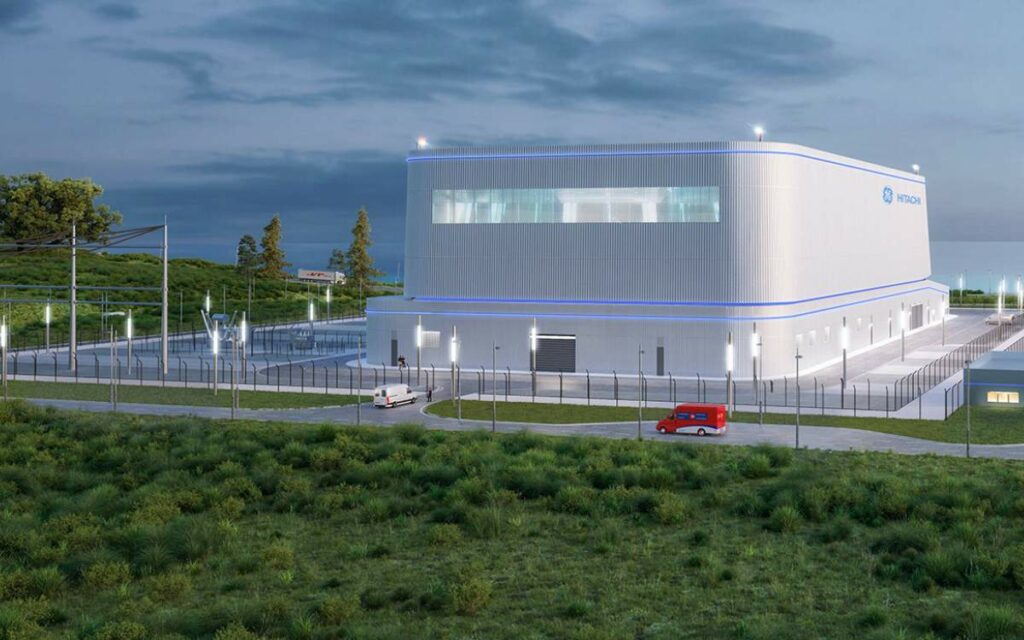
New technology could help reduce oil sands emissions in the future. Pictured is a conceptual rendering of the BWRX-300 SMR plant by GE Hitachi Nuclear Energy. The plant will be located at the Darlington Nuclear Generating Station site near Oshawa. Photo credit: GE Hitachi
North America’s first commercial small modular nuclear reactor (SMR) is expected to come online in Ontario’s power grid within five years, sparking hopes of lower emissions across the country, including Alberta’s oil sands.
SMRs can produce up to 300 megawatts of electricity – enough power to supply around 200,000 homes. They may be deployed for heavy industry, backup for renewables, steam generation, hydrogen production, and oil and gas facilities. They can be constructed in one location, then shipped and operated at a separate site.
“SMRs are like a Swiss Army knife of the nuclear world,” said John Gorman, president and CEO of the Canadian Nuclear Association. “They produce very high temperature heat in a clean, scalable way. That’s important because not only can they produce electricity, but they can also use that heat to do things like produce steel or extract bitumen in the oil sands.”
Ontario Power Generation (OPG), a Crown corporation, has teamed up with SNC-Lavalin, and Aecon Group to build a GE Hitachi BWRX-300 SMR at the Darlington Nuclear Generating Station near Oshawa, which has several large CANDU reactors. Four SMRs are planned for the site in the coming years.
The water-cooled BWRX-300, with an operational lifespan of 60 years, has a lifecycle cost comparable to a typical natural gas power plant, says GE.
In cooperation with OPG, Saskatchewan has committed to building several SMRs. Smaller units are planned for Chalk River, Ontario, and New Brunswick. In 2022 the provinces of Alberta, Saskatchewan, Ontario and New Brunswick agreed to jointly advance SMR technology.
SMRs could be part of the long-term plan of the Pathways Alliance in Alberta, a collection of oil sands producers representing 95 per cent of production working to achieve net zero emissions by 2050.
“They’ve succeeded in getting support to adopt carbon capture technology,” Gorman said. “That will help very much to initially bring down carbon intensity of oil extraction. But they also recognize it only brings them part of the way there. After you deploy carbon capture, you’re also going to need something like small modular reactors to decarbonize the rest of the way.”
In January, X-Energy Canada, a developer of SMRs, and Invest Alberta, a Crown corporation, signed a memorandum of understanding to potentially deploy scalable 80-megawatt SMRs around the province.
“This clean energy solution can directly support heavy industry, including oil sands operations, and petrochemical and other industrial processes, through a combination of high-temperature – 565 degrees Celsius – steam and electric power production,” said X-Energy.
In 2020, nuclear power was the second-largest source of electricity generation in Canada after hydropower, contributing 15 per cent of final electricity consumption, according to the International Energy Agency.
Ontario will require an additional 4,000 MW of electricity between 2025 and 2027 – the equivalent of adding a city the size of Toronto to the power grid, according to Ontario’s Independent Electricity System Operator.
Adding SMRs to the energy mix could help, said Gorman.
“It’s a lot closer than people tend to understand, and Canada has a lot to benefit if we can continue to move quickly,” he said.
This article was originally published by the Canadian Energy Centre (CEC). Read more of the CEC’s content here.




















